A critical element in screw press design is the screw-to-screen (s2s) clearance. This clearance is important because of the action of the screw pushing fiber over the screen. This movement wipes the screen clear, brushing the screen to permit the free passage of press liquor. Thus, the tighter the s2s clearance, the better the dewatering action.
With slimy materials, such as washed citrus peel, biomass digester sludge, manure, DAF sludge, potato peel, and spent brewers grain, the s2s is critical to successful operation. With other applications, such as spent coffee, corn silage, most nutraceuticals, and egg shells, the s2s is less important.
The screw diameter is machined to within a few thousandths of an inch. Thus the screw OD has always presented a fixed reference surface.
Holding the inside diameter of the screen is what has presented the challenge. Screens are made of fabricated (not machined) stainless steel. Rings, gussets, and honeycomb reinforcing are used for strength and rigidity. The welding of these elements is an inherent source of distortion in the finished part.
From the 1950’s into the 1990’s, the standard s2s was 1/16. This was difficult to achieve in manufacturing because the screen is typically fabricated in two half cylinders, up to 100 long.
Improvements in welding fixtures, screen design, welding sequences, and press alignment procedures allowed the s2s to be set at 1/32 (compared to the previous 1/16). The use of machined stainless indexing rings, built into the frame of the press, has assisted a great deal in improving tolerances. Also, in the small and mid-sized Series KP presses, the use of a cylindrical screen (instead of two 180 degree segments) has resulted in tighter tolerances.
Vincent is proud of these improvements. Without addition to the cost of manufacture, they have resulted in better dewatering and overall performance of our presses. This, in turn, has opened new markets for our machines.
Once a press has been in service, the best indication of the screw-to-screen clearance is found by stopping the press, opening the cone, digging out the press
cake, and looking at the tips of the last two flights. If they are noticeably worn down and eroded away, a more detailed inspection is in order.
Two instruments are used to measure the s2s clearance. In the case of a press with a perforated screen, the depth gage on a vernier caliper is used to measure from the outside of the screen to the edge of the flight. The thickness of the screen is subtracted from the reading.
In the case of wedgewire screens, a machinists’ rule can be modified so that it can be used to measure from the outside of the wedgewire bars to the edge of the flight. The thickness of the bar is subtracted from the reading.
The photos show the use of these measuring devices.
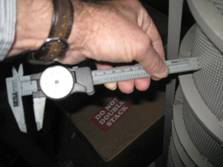
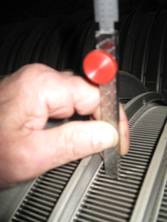
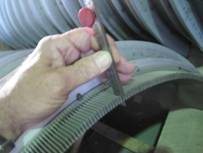
VERNIER DEPTH GAGE MEASURING DEPTH @ SLOT
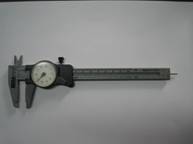
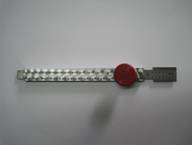
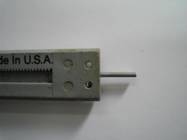
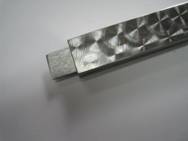
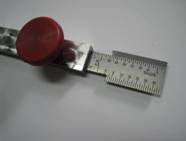
ISSUE #208
